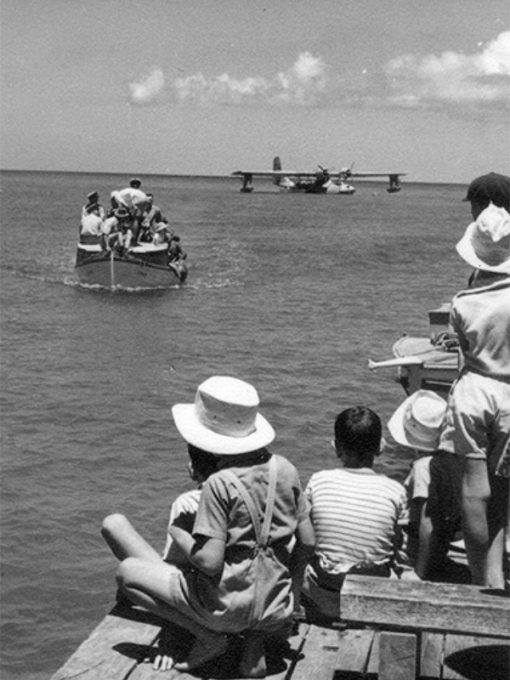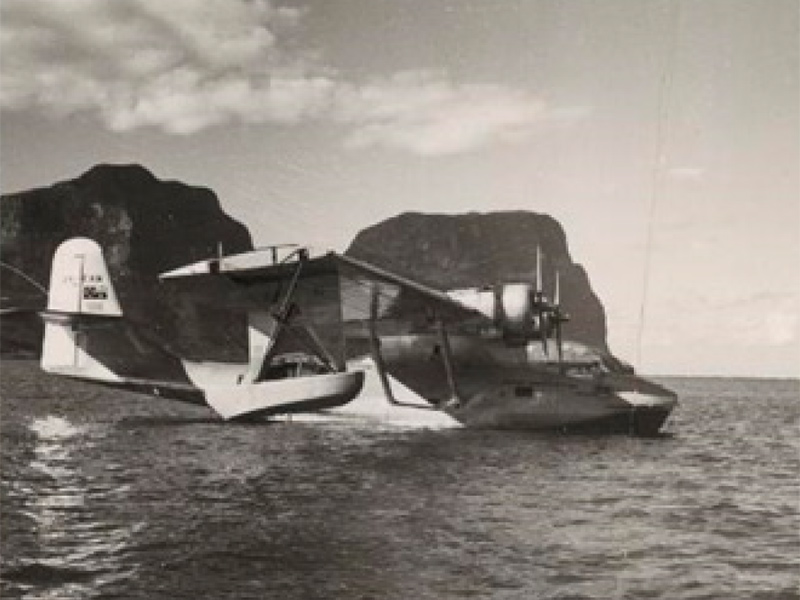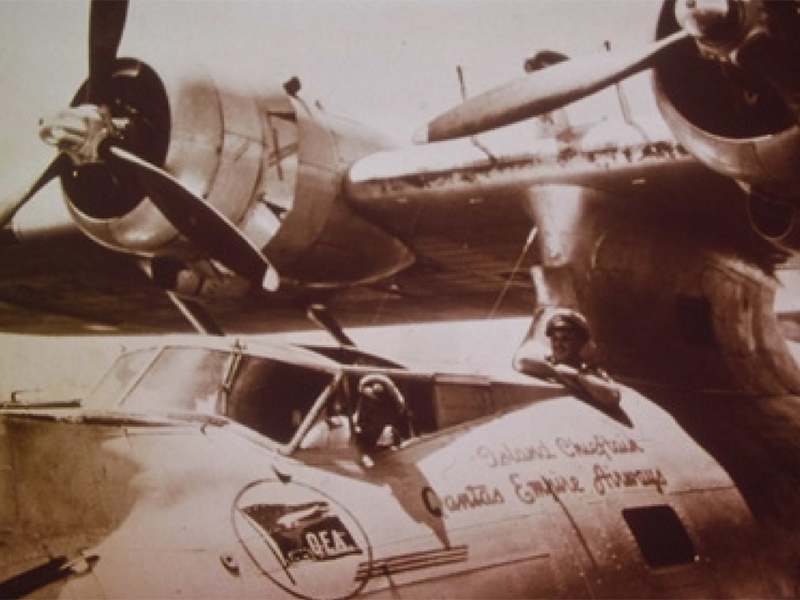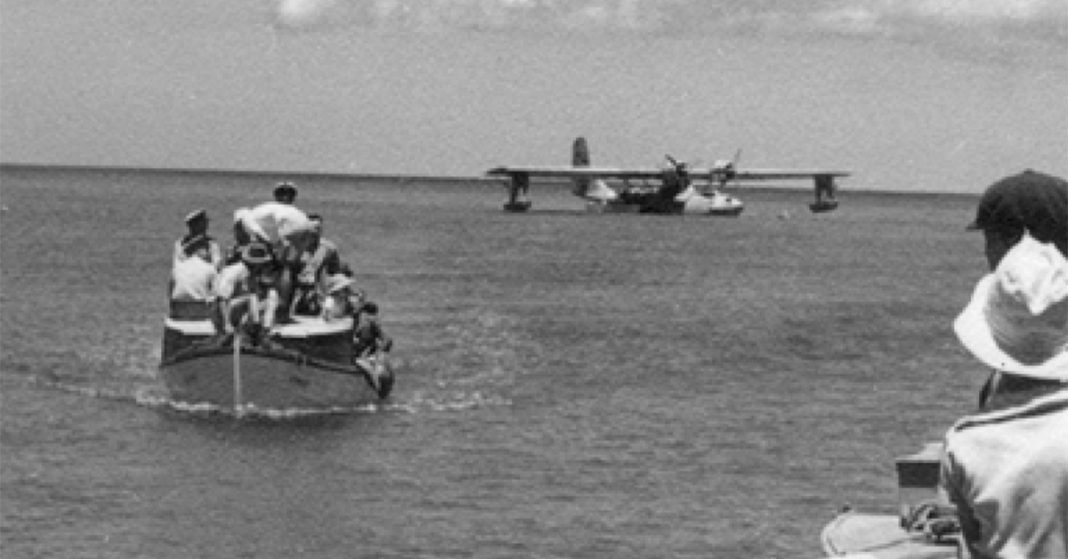Dear Sparks from the Past followers: We previously interrupted our sequence of Waterfront Wars from September to November, bringing you information about the 50th Anniversary of the Lord Howe airstrip and its construction in 1974. In the December Signal we briefly returned to Waterfront Wars but then, owing to the last “Met” family leaving the Island, and a request from one of our readers to write about a past performance of a “Midsummer Nights’ Dream”, the sequence was interrupted again. Once more, however, we return to Waterfront Wars which details the post war tussle between Trans Oceanic Airways and Qantas, and their rivalry on the Lord Howe route.
Waterfront Wars Part 15d The Qantas Flying Boat Service to Lord Howe 1947-51.
Doubly Favoured by both the Federal Government and the Lord Howe Island Board, Qantas should have enjoyed a dream run but, after the destruction of two of its Catalina aircraft (one of these at Lord Howe), and its focus on international travel, it very quickly lost interest in the Island.
The commencement of Qantas Empire Airways’ flying boat service to Lord Howe in December, 1947, had its roots in both national and local politics.
Prior to World War II, the Commonwealth Government had helped establish Qantas as Australia’s first international airline by giving it lucrative mail carrying contracts to Singapore where it connected to Great Britain’s Imperial Airways network. Following the war, the Government continued to favour Qantas, eventually nationalising the airline via a share buy-out in 1947.

On tiny Lord Howe, the Island community desired the development of a modest post war tourist industry. However, the community made it equally clear – in three successive consultations with the Lord Howe Island Board – that it did not wish to be overrun with visitors, nor did it favour an elitist, luxury-end, tourist clientele. Consequently, the Board decided to support Qantas which was the preferred Government carrier from 1947. Qantas was seen as being less profit driven than a privately owned airline, like Trans Oceanic Airways, which was also vying for the Lord Howe route.
In the Board’s view a Qantas flying boat service would be more closely aligned with the community’s desire for a low-key, non-elitist, post war tourist industry. Qantas, however, proved to be a relatively short-term player as its sights were set firmly on international travel rather than on the domestic market.
From “On High” The Federal Government View
Following World War II, the Chifley labour government wanted to nationalise key industries in Australia and, in 1945, the Federal Parliament passed legislation establishing an Australian National Airlines Commission (ANAC). It was intended that this government entity would operate a domestic airline within Australia. Although a decision of the High Court prevented the government from legislating a monopoly, a new airline – Trans Australia Airlines or TAA – was airborne by September, 1946. Then, in 1947, Qantas Empire Airways was nationalised via a share purchase by the Federal Government. Thus, within the space of one year, the Government had acquired both a domestic and an international air carrier. On the 23rd of April,1948, the Qantas board was told that T.A.A. would operate services within mainland Australia and Tasmania whilst Qantas would operate outside the mainland but including Lord Howe Island, Norfolk island, Papua and the mandated territories of New Guinea.
In the second of a three-volume history of Qantas, “Challenging Horizons”, historian John Gunn writes “On 9th December [1947], the first charter operation to Lord Howe Island, five hundred miles from Sydney, was carried out using the first of a number of reconditioned Catalina flying boats bought from the RAAF. Of far greater long term significance, on 16 December, a weekly Lancastrian service via Darwin and Manilla to Japan began…” (P. 250) (My bold italics)
Clearly, the Government mandate to Qantas was directed at international travel and, to a lesser degree, at a few offshore destinations like Lord Howe and Norfolk Islands which were administered from Australia.
Consequently, from the outset, Qantas was never going to prioritise Lord Howe. It is hardly surprising, therefore, that the Qantas service to Lord Howe was the shortest in duration of all the three post war flying boat airlines to the Island. Nevertheless, its contribution remains significant.
Prior to World War II, and for a few years after the war, flying boats continued to play a significant role in Australian commercial aviation. After the war there were scheduled flying boat services between Australia and Great Britain, New Zealand, New Caledonia, Fiji, Port Vila and Espiritu Santo and the important “Bird of Paradise” service to Papua/New Guinea. Flying boat services also linked various points along the east Australian coast including Hobart, Sydney, Port Macquarie, Grafton, Brisbane, Gladstone, Townsville and Cairns – plus Lord Howe and a few of the Barrier Reef islands like Heron and Hayman.
However, the future of commercial aviation was moving inexorably in the direction of land-based aircraft. By June, 1955, Qantas had ceased flying boat operations at Rose Bay, though Qantas did continue to operate flying boats internally in Papua/New Guinea until 1960. Symptomatic of Qantas’ diminishing interest in flying boats, its Lord Howe service only lasted three years and three months from December, 1947 to March, 1951.
Despite Qantas’ more limited role in restoring post war prosperity at Lord Howe, its contribution should not be underestimated. One of its Catalina crewmen, Ken Anquetil, who flew into Lord Howe as a Radio Officer with Qantas, and recalled how Qantas had “helped the Island to build its tourism” and also carried “urgent medicines and the mail.” (Letter to the Island Museum dated 22/12/2003.) A Lord Howe Island Board Report to the Chief Secretary’s Department (1948) stated “The future of the Island is doubtless in the tourist trade, and the regular air service now provided by the two companies (Qantas and Trans Oceanic Airways) assures a constant stream of visitors from the mainland”.
Qantas Flying Boats and Lord Howe Island
The first Qantas survey flight to Lord Howe took place on the 20th of November, 1947. The aircraft, VH-EAW, was a Catalina PB2B-2 twin engine long-range flying boat, crewed by Captain Len Grey, a first officer and three other crewmen. The aircraft touched down at 1.19pm after a flight of four hours and five minutes. Also aboard, was Captain Orme Denny, a pilot who had risen through the ranks at Qantas to become, in 1946, Assistant Operations Manager. Denny met with Tom and Babe Payten and arranged for them to act as the local agents for Qantas. While at Lord Howe, Captain Len Grey carried out a survey of the lagoon assisted by Gerald Kirby and his motor launch, Albatross. The captain’s logs of these first flights provide detailed information about their departure and arrival times and flight duration.
Qantas’ first passenger-carrying service was scheduled for the 3rd of December, 1947. It departed Rose Bay at 8.20am, once again piloted by Captain Grey, but was forced to return due to adverse weather at Lord Howe. (The Captain’s flight log recorded a flight time of 8 hours and 53 minutes in which the aircraft failed to reach its intended destination!) The first successful commercial flight departed on the 9th of December and left Sydney at 11.39am with 14 passengers who must have been very relieved to alight at Lord Howe 4 hours and 17 minutes later!

The Qantas Catalinas only carried 14 passengers compared with 28 on TOA’s larger Hythe/Sunderland flying boats. However, the Lord Howe Island Board, in a letter to the federal Minister for Transport (August,1948), requested parity in passenger-carrying capacity between the two airlines. The aim was to control the number of flights so that the supply of visitors did not outstrip the Island’s available accommodation. Even so, the operation of two airlines created problems for the Board.

In January, 1949, there were press reports of people being accommodated in tents at Lord Howe! The passenger-parity principle ensured that Qantas operated twice the number of flights in its smaller aircraft one per week compared with TOA’s fortnightly service. Taken together the two airlines delivered a maximum of 56 passengers to the Island per fortnight. However, extra flights were allocated during the busier Christmas holiday season.
The Qantas Cats were reported to carry a crew of five: captain, first officer, flight engineer, radio operator and steward. At the time, Qantas had extensive flying boat traffic from Sydney to other Pacific destinations so a great many Qantas crew visited Lord Howe. A group of Qantas captains who joined a 40th anniversary celebration on Lord Howe in 1987, included – in addition to Len Grey – Hugh Birch, Ashley Gay, Tim Reeve, Bert Richie (later a General Manager of Qantas), and Phil Mathiesen (who flew for both T.O.A. and Qantas).
For most of its three years at Lord Howe, the Qantas service seems to have operated like clockwork. There were, of course, occasional press reports of Qantas Cats being delayed or having to turn back to Sydney due to bad weather or maintenance issues. One in the Sydney Morning Herald (Wednesday 31, December ,1947, page 4) states that “A Qantas Empire Airways Catlina flying-boat, bound for Lord Howe Island was forced to return to Rose Bay yesterday because of engine trouble.… One of the ten passengers on board was the Government Chief Secretary, Mr. Baddeley”. Such occurrences were not unusual and affected all flying boat operations including those of T.O.A and later, Ansett.
On another occasion, a Qantas Cat was delayed at Lord Howe due to a huge dust cloud drifting out from the mainland but still managed to evacuate a woman with appendicitis. The Sydney Morning Herald reported (Thursday, 14 October, 1948, page 3) “Dust Delays Plane With Sick Woman: Thick clouds of dust blown from Australia delayed the departure of a Qantas Catalina from Lord Howe Island on Tuesday with an acute appendicitis case on board.
The dust was so thick that visibility was less than a mile, and the Catalina could not leave until yesterday. Miss M. L. Johnston, of Brighton-le-sands, arrived at the island on Friday for a three weeks’ holiday, but became ill on Saturday night. When the Catalina reached Rose Bay yesterday she was brought ashore on a stretcher and taken to St. Vincent’s Hospital by ambulance.”
However, these events were minor compared with two that were about to be unleashed on Qantas: the destruction of one their Catalina flying boats at Lord Howe in a north-westerly gale; and then a second aircraft destroyed by a mysterious explosion and fire at Rose Bay. These dramatic events, and the end of the Qantas flying boat service to Lord Howe, will be detailed in the next Signal.


